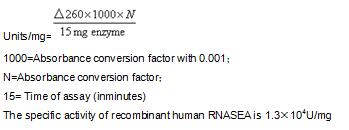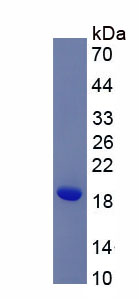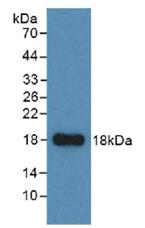Active Ribonuclease A (RNase A) 

RNASE1; RNASE; Rnase-A; RNase UpI-1; RIB-1; Ribonuclease,RNase A Family,1(Pancreatic)
Overview
Properties
- Product No.APA297Hu01
- Organism SpeciesHomo sapiens (Human) Same name, Different species.
- ApplicationsCell culture; Activity Assays.
Research use only - DownloadInstruction Manual
- CategoryEnzyme & Kinase
- Buffer FormulationPBS, pH7.4, containing 0.01% SKL, 1mM DTT, 5% Trehalose and Proclin300.
- Traits Freeze-dried powder, Purity > 90%
- Isoelectric Point8.8
Sign into your account
Share a new citation as an author
Upload your experimental result
Review

Contact us
Please fill in the blank.
Activity test

Ribonuclease A (RNASEA) is a member of the pancreatic-type of secretory ribonucleases, a subset of the ribonuclease A superfamily. RNASEA cleaves RNA on the 3' side of pyrimidine nucleotides. The protein acts to degrade ds-RNA over ss-RNA. The activity of recombinant human RNASEA measured by cleaving yeast RNA. One unit of the enzyme causes an increase in absorbance of 0.001 at 260 nm in 15 min when yeast RNA is hydrolyzed at 50°C and pH 5.0. Pipette 50ulof respective recombinant human RNASEA dilution into 100ul 0.1M sodium acetate buffer, pH 5.0, then add 150ul of 0.15mg/ml yeast RNA. The blank tube use 50ul ultrapure water instead of enzyme dilution. All the all tubes Incubate at 50°C for 15 minutes. Read A260 versus blank.
Usage
Reconstitute in 10mM PBS (pH7.4) to a concentration of 0.1-1.0 mg/mL. Do not vortex.
Storage
Avoid repeated freeze/thaw cycles. Store at 2-8°C for one month. Aliquot and store at -80°C for 12 months.
Stability
The thermal stability is described by the loss rate. The loss rate was determined by accelerated thermal degradation test, that is, incubate the protein at 37°C for 48h, and no obvious degradation and precipitation were observed. The loss rate is less than 5% within the expiration date under appropriate storage condition.
Increment services
-
 BCA Protein Quantification Kit
BCA Protein Quantification Kit
-
 Molecular Mass Marker for Protein
Molecular Mass Marker for Protein
-
 Monoclonal Antibody Customized Service
Monoclonal Antibody Customized Service
-
 Polyclonal Antibody Customized Service
Polyclonal Antibody Customized Service
-
 Protein Activity Test Experiment Service
Protein Activity Test Experiment Service
-
 Electrophoretic Mobility Shift Assay (EMSA) Experiment Service
Electrophoretic Mobility Shift Assay (EMSA) Experiment Service
-
 Buffer
Buffer
-
 Lentivirus Packaging Experiment Service
Lentivirus Packaging Experiment Service
-
 Adenovirus Packaging Experiment Service
Adenovirus Packaging Experiment Service
-
 Real Time PCR Experimental Service
Real Time PCR Experimental Service
-
 Spike RBD Protein (S-RBD)
Spike RBD Protein (S-RBD)
-
 Protein G
Protein G
-
 Protein A
Protein A
Citations
- The Human Host Defense Ribonucleases 1, 3 and 7 Are Elevated in Patients with Sepsis after Major Surgery—A Pilot StudyPubmed:26927088
- The Proteomic Landscape in the Vitreous of Patients With Age-Related and Diabetic Retinal DiseasePubmed:30025106
- Human ribonuclease 1 serves as a secretory ligand of ephrin A4 receptor and induces breast tumor initiation33986289









